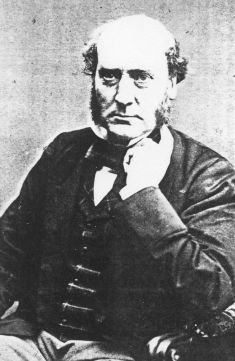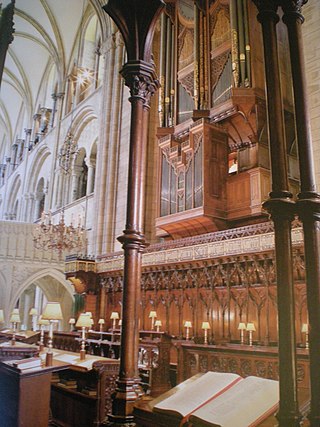
Charles Henry Hylton Stewart (1849 - 1922) was an English clergyman and organist.

Charles Henry Hylton Stewart (1849 - 1922) was an English clergyman and organist.
Stewart was educated in Bath, Somerset before entering Christ's College, Cambridge in 1870. Migrating to St Catharine's College in 1871, he graduated B.A. in 1874 and M.A. in 1877. [1]
Charles Henry Hylton Stewart was Choral Scholar and Organist of St Catharine's College, Cambridge. [2] On James Pyne's departure, he acted as interim Organist of Chichester Cathedral and was formally appointed in May 1874. [3] The following year he left to take Holy Orders and was successively Minor Canon Precentor of Chester Cathedral (1877–89), Vicar of New Brighton (1889 - 1904), [4] and Rector of Bathwick, Bath (1904–16).
His son Charles Hylton Stewart, was Organist of Rochester Cathedral and of St. George's Chapel, Windsor.
His second son, Bruce Hylton-Stewart, played first-class cricket for Somerset County Cricket Club and appears generally to have used a hyphen in his surname.

The Abbey Church of Saint Peter and Saint Paul, commonly known as Bath Abbey, is a parish church of the Church of England and former Benedictine monastery in Bath, Somerset, England. Founded in the 7th century, it was reorganised in the 10th century and rebuilt in the 12th and 16th centuries; major restoration work was carried out by Sir George Gilbert Scott in the 1860s. It is one of the largest examples of Perpendicular Gothic architecture in the West Country. The medieval abbey church served as a sometime cathedral of a bishop. After long contention between churchmen in Bath and Wells the seat of the Diocese of Bath and Wells was later consolidated at Wells Cathedral. The Benedictine community was dissolved in 1539 during the Dissolution of the Monasteries.

Sir George Gilbert Scott, largely known as Sir Gilbert Scott, was a prolific English Gothic Revival architect, chiefly associated with the design, building and renovation of churches and cathedrals, although he started his career as a leading designer of workhouses. Over 800 buildings were designed or altered by him.

William Juxon was an English churchman, Bishop of London from 1633 to 1646 and Archbishop of Canterbury from 1660 until his death.

Wells Cathedral is an Anglican cathedral in Wells, Somerset, England, dedicated to St Andrew the Apostle. It is the seat of the Bishop of Bath and Wells, whose cathedra it holds as mother church of the Diocese of Bath and Wells. Built as a Roman Catholic cathedral from around 1175 to replace an earlier church on the site since 705, it became an Anglican cathedral when King Henry VIII split from Rome. It is moderately sized for an English cathedral. Its broad west front and large central tower are dominant features. It has been called "unquestionably one of the most beautiful" and "most poetic" of English cathedrals.
Jocelin of Wells was a medieval Bishop of Bath. He was the brother of Hugh de Wells, who became Bishop of Lincoln. Jocelin became a canon of Wells Cathedral before 1200, and was elected bishop in 1206. During King John of England's dispute with Pope Innocent III, Jocelin at first remained with the king, but after the excommunication of John in late 1209, Jocelin went into exile. He returned to England in 1213, and was mentioned in Magna Carta in 1215.

The Choir of St George's Chapel at Windsor Castle exists to sing services in St George's Chapel at Windsor Castle.
Simon of Wells was a medieval Bishop of Chichester.
Sir Edward Stafford Howard, was a British Liberal politician and magistrate.

James Kendrick Pyne was an English organist and composer.
Dr. Zechariah Buck, was an English organist and choir director who is remembered as a preeminent trainer of boys' voices.
Reverend Henry Watson Barnard was an English clergyman and amateur cricketer who played first-class cricket between 1815 and 1823. He served in the Church of England in Somerset and was a canon of Wells Cathedral.
Bruce de la Coeur Hylton-Stewart was a musician and schoolteacher who played first-class cricket for Somerset and Cambridge University between 1912 and 1914.

Charles Albert Edward Harriss was a British-Canadian composer, impresario, educator, organist-choirmaster and conductor.

Arthur Charles Lestoc Hylton Stewart was an English cathedral organist, who served in Rochester Cathedral and St. George's Chapel, Windsor Castle. He also produced several compositions for organ, and a few for choir.
John Charles Halland How OGS was an Anglican bishop.

The organs of Chichester Cathedral are the major source of instrumental music at the cathedral, being played for daily services and accompanying the choir, as well as being used for concerts and recitals. There has been organ music at Chichester Cathedral almost continuously since the medieval period, with a break in the mid-17th century during the Commonwealth period.

Edward Hoare Hardcastle was an Anglican clergyman in the late 19th and first half of the 20th century.

Haldane Campbell Stewart was an English musician, composer and cricketer. He was organist and choirmaster of Magdalen College, Oxford, and a composer known for his liturgical music. He played first-class cricket as a batsman for the Kent County Cricket Club.
Henry James Marshall was an English first-class cricketer and clergyman.